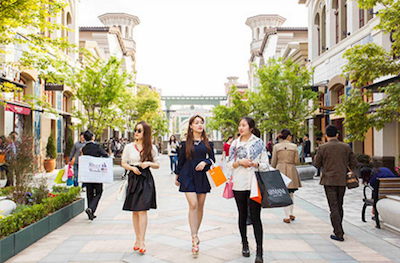Emerging markets are going to be the key drivers of growth in fashion next year, according to a new collaborative report from Business of Fashion and McKinsey.
2018 will mark the first time that more than half of apparel and footwear sales will come from countries outside of Europe and North America. Luxury fashion in particular is projected to grow between 4 and 5 percent, largely in line with the expected increase for the overall industry.
"In 2018, more than half of revenues in the global fashion industry will come from new markets in the East than long established markets in Western Europe and North America," said Imran Amed, founder and editor-in-chief of the Business of Fashion (BoF), London.
"This is an important symbolic tipping point as business leaders across the industry continue to gear themselves up for growth, amidst a backdrop of rapid flux where new technologies, new consumers and an unpredictable macro-economic environment continue to challenge leaders to rapidly shift their strategies and operating models," he said.
Fashion forecast
“The State of Fashion 2018” surveyed industry executives, and found that volatility and uncertainty was their top concern. However, when the researchers analyzed the responses, they found that the third most-used word was “optimism.”
Despite challenges such as competition from online sellers and falling foot traffic to stores, the overall fashion industry is set for a growth of 3.5 to 4.5 percent next year.

Fashion executives are positive about next year. Image credit: Neiman Marcus
Looking to position themselves for growth, the top category fashion sellers are investing in is digital, including upgrades to ecommerce, omnichannel retail and marketing. Others are focused on increasing their cost efficiency, whether through worker productivity or adjustments to their product assortment.
Combatting the unpredictable geopolitical and economic environment, brands will need to be nimble and able to react.
Additionally, the report notes that while there has been a growing embrace of nationalism, digital connectivity will pave the way for more cross-border fashion activities in the coming year. From online retail transactions to hiring talent, brands are able to be more easily find international footing.

Asian consumers are remaining a growth driver in fashion. Image credit: Value Retail
One key region fueling fashion retail will be Asia, which McKinsey projects will account for almost 40 percent of apparel sales by 2018. Asia’s online apparel sales are estimated to reach $1.4 trillion by 2020.
Along with providing a customer base for fashion retail, Asia also boasts two-thirds of “ecommerce unicorns,” feeding the needs of the region’s digital native consumers.
Asia’s outbound influence has been seen in digital innovations like WeChat, which other social platforms have based features on.
The report also anticipates further investment from China into Western companies, such as JD.com’s Farfetch stake (see story).
One trend that is crossing continents is the growing embrace of off-price retail. U.S. shoppers have embraced the format, and a number of luxury retail chains have obliged with rapid expansion of their discount brand footprints.
Europe and Asia are expected to see their off-price presence grow, which could harm brands and lower margins.
Trend report
With social media driving consumers’ desires to be original, exclusive products and personalization are going to be popular. This could mean a customized garment or individualized marketing outreach facilitated by data.
The culture of sharing and self expression has also led to lessened acceptance of less-than-transparent communications.
While upwards of 60 percent of luxury consumers already turn to digital channels to research a purchase, McKinsey and BoF predict that online platforms will become even more important in the coming year.
For instance, JD and Tmall combined own 80 percent of the Chinese online apparel market. These retailers have been making inroads into luxury, launching verticals that present labels in a more curated space or creating elevated delivery programs aimed at the luxury buyer.

JD launched a white glove delivery service. Image credit: JD
Amazon has been less successful at wooing luxury fashion brands, but it is set to unseat Macy’s as the top apparel retailer in the U.S.
"Mastering digitalization across the entire value chain will be critical for players in most of the segments, not only luxury," said Achim Berg, senior partner at McKinsey, Frankfurt.
"However, luxury...has been a somewhat late adopter of the digitalization and hence has some gaps to fill," he said. "On the other hand, the in-store experience is important in all segments but likely even more important in the luxury segment and they have therefore managed to stay attractive even if a late adopter."
While fashion has not yet tapped into the full potential of artificial intelligence, the report anticipates that next year will bring more adoption of the technology.
While artificial intelligence has been thought of as computerized solution lacking creativity, a report from Fashionbi explains that AI-powered creativity will be a new frontier for fashion.
Through the use of data, fashion brands are now looking into creative solutions that build a unique strategy for streamlining trends as well as personalization. AI is now also powering three facets of fashion, according to Fashionbi’s Artificial Intelligence in Retail report, such as customer service, product design and within the shopping experience (see story).
Another trend expected to drive the industry next year is sustainability, which the report anticipates will be at the core of brands’ operations. Rather than one-off corporate social responsibility efforts, a desire to do good will drive innovation, with initiatives thinking beyond selling one more piece.
British label Stella McCartney is joining forces with The RealReal to market the reusability of luxury fashions, prompting consumers to get on board with the circular economy.
To celebrate the first edition of National Consignment Day, an official holiday founded by The RealReal, Stella McCartney will be promoting the resale of clothing through its boutiques. With concerns about the environmental impact of the apparel business rising, secondhand sales are one tactic to combat the fashion’s footprint (see story).
The report points out that there is now a winner-takes-all environment in the fashion industry, separating successful brands from those that fall behind. This calls for bold and brave tactics to come out ahead.
"Ensure to already now focus heavily on managing the seismic shift in the industry," Mr. Berg said. "The one managing that shift in a great way will the be winner, the one that doesn't won't."
{"ct":"wwEnwuxGxgdCBrkHIp3obfEszC7r20MWYQhAiCA+q8vFVdRH35OUNqOvsmVMCxDjl5EgrBxx2bEPrX6gxNu5UTLYzEb1m0sLak6sEZ\/d0yLLCECEJlClDnnAX7+8b6\/ZiIgPfU7HGo+H1h3H7n8is2NQl52ydmv28imapKYXzs1BJio7++2NcIwakYbIV8n8f8N8\/TvYNLtw9No6vizLjVnMPURDXGmEHfxrUGZrS+IlgavfHhaGQS4WiNK2jchHIMqeoLKPtCtoeyrhGAefyd0ZD6Jp2GrkLW6Pd2G+dD1Ki40poI74F5\/RhN1IgilBRQAxdWkeXKkXwfes9kTqyF\/r0rytDwwh\/vJSz+Ycvq7P68veXf6J7C17FTROZDduoxyN3WojaJDOrnUWRqk9zw\/aCy9EpUvUYL8erpWpcsVcVIT\/s5dUPgo6VFcK8fgnCSZiJ7hOAq1TAIk8HCQD4r8jhWKOT4jcoxBZjhBRF5qWnJ1j\/50EFRRoO\/9GgWO3cDvPgCUF\/VFCRNi0PRv5MtOjpKWq13X+ugKwqQYPlu2StnoI5UqQTHQEZ3Kl7103P2yoGqM8ZJRwNeelDfTWRgabmLFamf8020LoM0bBfSO4MPnra16E1mKMgQuXAX7sQ40hqTFZ\/SJGhw2ytnLwGNDJpYuQtcL6udrXP6bjxrd89fH6B\/j3rYB5Q0OPv06AvKhP3y0SHu8t\/uXR3MVMcqq5rB8gBY+KFgp\/Qb5onm5lmQ1h67WnWOR0M\/1tc9oVBvIAhn3f8M9RMobBl\/0FecuoWCVRWR04JTwV2XOJA4\/uoceCJ0xnunp2Hex+ZuXMRF1pQxvxL6ZWuPV0iGioYH9w7kbQSY8BkYxFIVtNa3kK3+YB4uwPDMYqetypHesxKIVE4HAhtC4+owYz+xFVhd\/CInfFIVwR\/2oj9ex7Zavfb5E7DE\/kUl8hp\/ODIDXuPJ99m0i+p5bdY6iHwyAnc0A\/uYEXbs6MBCt8ZYGzTFLBM6S\/R8ht1KXYk4VjKAJsh2QlsS7wHQUQ7578PwWYheU5aW1UFI4MX5nCwpx1+s0JeDmS2StQDZvPD0DEsrfIaZkHeKBMPeC8wZ6cMvYHVL5cfqY2FqUt+DXp2IEDQiPaTKjSIPc4jXawE6ek1s4qbmSM6Jp7Be9meqk4Ap+29r\/V3V0gboWBniURiqabwnfsafvB8MFFVnahqQXy9yG0BHJV9VyuRbQlX6gLVfFmNcy6rlc5g\/XHajnj+T6HMy9hjFYJyEQcLVyXKhcOctZ2TJTSkyyR6vQ4X2oWPXAhmF7ER2Ous\/dUIndTqcxy2xA7wlrLcx2h3uO6vnh+jY7aaqtePn3n96kcHGgrAeTwsw6I+zqffKYxpeVhrNI2+c\/iuhGYv7d+zXYLOL0N5Q+NiWoRc5UgFukMd0hpm5ESkusCnTDIKxUoFCBHVKG74TEIZkt+4GDw+Aap60VpCPmUpTbY+DCCcYqaBA8kGWKTPFBK4S1DRIYOlpEpXhrqmfw6jUM7yT6DItSivPkaCMKhRzhTIO+zVsXqPzT16x9SHUXbJiDPi\/cXjQP4q+OUQWO1bgwZgh\/ipyaEKDO6WZFpv5gJkV90Ot5ul+HV7L7+5mJNH8XgZb\/i2lpwcR7qH8FCjeTLPnygl8iRmrtpPCVX\/nJCe+LpgDMvysS3AGwpvNH3VwTA6CMg2kGbpUsIjftrapNlOl12Os6u5hLN0ZG\/1dduiM0NyA5sVUjVUCjrtR6hmKIdaA0tt+oAxW2ooZl3Lw6QgC72kgr9VePOz0o4AWocazbYdM0o7JbvjMXMwZ2AILOEF6cVR7C6\/w1V35eIhRchU7VoLL4E1+Eg5xJUiWWBaSrK8U3rr3mKA+Amm7gOf44IBV+J56O6A1miJ0DLl5fmt8GMmYNeBsgqF5Wl+nYR\/e4hkXxjCiFmD8owlIEnjKLYUbsAr0bV6nR7lsCLjNZEbP77BVHpl342Ym7+m8Ulmw7uF9VzHwHcL+bPR3TZCdNiaPIYp67uFjCP5N8M6wneRXiFIxMP0VAxb6FrPNrk0jtAzTMCFLDW8R\/2krjpKu7eTMcwKbVckbeYWrDamlNnfDZIclSUh+TqggVYoEQqTksFK95iu4O2WKVG3onTctOGNIkEwKYaWJ38GCBJYxX2CoGTHuNeKO1ukvnNHvz88R9x8Ex8fTdGwy86+Ex+OX7klIXoqByYcrINn4\/1hd58A4feRzpzVpgd\/S0wkoGlUW7drXldY0YXD6e74UldD\/ZCMV4HnRMVkS8eTY+0E7mDOFA2LJiihTIQ8Boq8qjVZnJQrG1on9FljZSvlRwSduiHI9HjqTQq0MBDkQSsVmSComS21wFt3iQVJ+gMtC3Hpv7KnRzTOHMs89dD8OlOyumqXkdmDtHbuYR8b1POp1IaWP9ngoSIbr0DJnypEZ\/+ZMeviiVTXSqH1A\/bBqgmFMJ2uF1tuQqvQRtJc91w6b0csd6XxdYluHymKwWWcGQZW2S0TS9DvLC4zmCWY3L3CCEwIchsuok0lVU4Cx4U6kFWsDAB0hVSKfZG08WDRciYVxZ0LGj0KxKavz+JayUVC7IrnCbwn9wXXEBVb\/w53vW08qxK3D4KCJZihcUjfBiDx0bLjho0DVQKV2h3yf+agRRBCl4nqgHZCtr+LcTnnFYxaFOXQZkzB6UHxtmWK9Mnvw7bEz5g3+tlUzv\/W4L+B7s8UBhcoFlt\/Zh6cMUG3QXKuKu32wFzsLjPd719HeoAEWsjxSEuqSSkV1TSRhAAZ4KYdnwLDHdQWNiIZOCUgZ7WyaXFNf\/yGg3yTERhDDsY4JJf8wVsxNZx1gBZ\/xPGhDU7Luo6POWFLy\/ZyHfC0i9v7BJg\/aG7zls2PeWGcMmZ+JKIG\/iNiVhtMA1sxg7ILj0GNBNI1c9YmlbSMZGTWQ4DSsSr4iosxBW6A56I9en+8Iw+dX\/dIfBto8vxMR1cwczIsDqKuv6T6xQPdAiHNaksaVRrEtqQze3BTtUndZU5SoqRN08RaZ9Ptl7Ucdu9nzwodzk\/YBZVHZ25jLPt9BT01LF8meCWoPw73dQhMtQz0rj0HnnzvX7tZztV1mxhbqGK4z4Ak\/xTIuswsRdjMiKxceim0rja0q1VmRr02upFsoNL\/OSQkLXJqfUIAxz9xqSECYhO7Qwt8Hx4KTxp6rFyS0aJMtv0uMWxr7DlqrscDXLERxx\/a3ZFUJOYtsjP4O+8DiqPyfyVNN\/gqkJg0Q9FuDY+UdHBrnzTrpbZ7G2+gyCrxea93RjqgKfcwTMKeEFOJtEPsiEGplwU2SLIpZzxe0z2lnF8Aq9RllsqHN7LafsxMdlrN01+hwOOdlkQdxjDFyvYmewb+4eqGZq636kSAQBLEg4vxJXgNnOxzaKdLQF\/dGfQ18WnGAhYHwYL\/8hqkvShINeMTrfy+THE8g0gXlk5sFfV3\/aQvv6hr0D28N\/ZMK6FTgtxczBXv1TiLsF0ejE2TRe5hn7wgTcmVv9yd8sqE1PoePXS8nHK9aKUQLVOqltqA5Vb+6yAniovZvYDsAldExlyFa\/3yFM\/rISoP4dqdtLGORNG\/iIjrH6iyJUA1blomvjj2E\/P\/C9VDnkbdOg+4WZ+PI0eC+Jqstx06dGVHsScs1\/Bgcy9YXlVkiRBgWI\/Vq2JrSpDkRl78vaTkwnedWnRTQ0tbSUyuDBqn6Jhy6wZeW2bxUMT+qZEUYzXZOaxGoEjhqON7rbtJM9EglT2wPAlB9IL+xyJ8zkhN8AzV\/W1G4Lgsw724plzbYS7GMuIKI4zkQUPANOvIY1udzTc5SWQP0MwcOFzqkRs7VIAn3C23mOQoEH0JemnnQIfypzxZ\/g2XvDliSqQPwT5G1vLTWUIKyJCf6dWwfXwbTouo2w\/d6znSJpNAytYk5O7OoKEvIITh31iUUunl0SVp0Nzrrr9F9GLUDRm6qN8PHBt220\/EE7hBN+KvHs7SWMs+Sc8U7o5viCzczcvDxXV6H\/IivE50lyuh9Ges3uI7eviifPf2Py79kWsJllfCbI8yd4rFklZMEGXPTfOlrR9OUoaaoN9eruG6wtOH5BAx2LZdp3rDS8mEtDU6cde1+WPE+n+lfpjuVdFmk5+uZRn8qtXpkIq29iZx42GdUt4M9E14cnIRme+CrI89bW4g2I\/VRDrbKFmIGNtMfGdii+O\/hKfrfUGo4I00ioVxWr\/FoVoNJ3MPrukGB2vhBOThfKAXklURa31TByCFeQ4K5zRkP2YV6qiIgqqNzaMP7vxxc1TWAIOWIksCRuhdK+xpWEr1pWnBaw1AxLUa8xzFmD45baQIEFBbBbQD\/14CS9MJ4RuX0KwTPxv9p3I\/WEQCai3uP7ybd0RUuszvGNWxJZvBVT5yEKFgjfvBfmsfczKanOWpAM3uFL\/e7msL64sDwhSw0JC\/uuDGztD46xclKOytafhn3oG3KIyKNKo9d\/y6VLvg5NDXZIEOiUVud+BYuMjrE6mstD4Ma4OdsPj73D5qBpLHdD6Im9lFxNrTGgbf0LNF0RIT90XvEoOz7nFH7Z33F6l1ut90nZGlR6cWPlj+F3LH5cqRpoe5aYFRW5IV0kRjECCl+RdfOfHgNJgj3qsPGEUjUz6HVnZ1q3gh2\/p2SttXQzkU3TPw3YzsEcsx63LO1P5NHhUxUVPP2T0Pjea2pC9JxqjN2u8K0nJC4XM1Yey1jj2hvm5mk0CZZjh8JlvsVX7CxnurIoPMYdEVAzLucTHakB2tT9FkzVCWaXAENBZ3LSzgSg0GEzHPxp24Hc4cZZQJvNOmufrkfH0tRW4EoaTjF1d0veTHiBUn3Jmp1uJBO8Nqa9KkfhO0kbu2r\/9BYNZzqYPNqJ47hbsq5aIZvYqmSzLwdQslx+hS\/tcce6qII5lqrCiLa7G\/vZQhIOL6egxU8T56SXlez4KnyBEtFaPDt13Z1sdnRgzRWST7hmiDrCjZwll48A1ICJbfxjEd6MmyXM\/osvpc6BxbcrhqM8mFX3KQTQYMZi3Mdz0zabm1aC\/j4rBE6xyqCpQmQFRpL44m2upiI6Urnpb57iENOczE3hCHlIuReX3k2jjaWwSP6VD6IT4vZYbrlfXI7T5SSbjqdc1hchtmwUK4S\/KmoswZILPiF9sJfvcMHhNn3iIjIPxRGx\/4bHTgDs7FD12aXRZEnGl6UvmEuMARIxVG\/Oiu\/Up0\/+y5p6Y3WWihU6nSM5hntSk\/UiEbV1iz1LcTNCYe\/5YQMcNXYW7MNUncWLrTonUZynByPb\/w0HKcBN5Xvf7j5q0i07G+rYRUh5bLUrnfMou3g0x0qg48Ry3OXMVrQzrb8QqZeOTpJYDkS7pldcJmvrD\/M2EjKEEb40JkZJKPBEEdbVjgVuLKg5xSnOVqtgvbxMT6\/XU9d0ZIFNrTdw9+ph7xxYvIYAjFsoHF2iIZpMM82LNRDQka8cCbxfwGNgp0uur80knfPJhIWcdK4csNjVKUMStIyEnimW24RvQAkSQztwiBX+DVN0vlOVv7rXLRe1J2M4PFJZ4r1Hg1NMCFtMP\/ETr6EAyNEsD2jOxPmRzkNOSQ5CYmUO61DBoZX0AxWvHNS6Fdm1unqPMQWDaJvYqPglq83FTdQMCjk7GtRXTpH98PDmJ3NqOfskCPIiu4DeRAeLytmIkTzx3plKqxZAyAhAeiz9qekBNlzHSu1RtK7pseuruLed2HKVvC3hLsDECF+Twu0dWKpDj9mreuhPfIU5NGRDmnhAIvOfpsriLp1zuElp0X8k7kdGV2wUo4869vOx6NKMMI04z8rybi8laQDZpY6n\/h+iLfi1NfT26O5NYOIO\/7zHsgCwPLAwAiNjW9Mk3TZOkOxdGRsoiChkB0AwYalGqbYEFEw0D8va3QaRYjGd32gC68OWj4C9s7Toqls5NatCTLPXSsjFw4TMRWKyxwMOtolfhr54hjDpnsTt02TYvp4BYOBCZJubBaWiuHtrKTmHQj9lpnHi0jVK1Cp5JvKgx2+Tr4vr+5QMfqP3o+m0UA6xr9PNQLUjb0P4wwY82dS2oYo8sBJ7WYlL4JKXW12\/Res5l4oFI9F1tdBPp7I\/OuMWAQOd4d38S7Ex5N+jpIhQl7\/b0vG2C9ckCutZTFVUbdFumQsGNOUaxuZmCIaJtyIqFL4npAepND4xvJHj6qZBh0HnRKOFD3ZBz2ihWUcS4ba9XiBsWYgbrKwAjEuY4he2HMRCUv5mpUMlPGJ\/sAYiHSqxjRxBQ5DySwGk3lTuQCG9ipuBnowafAUSBqoVzU\/VgbQLgDg2RVv4R9pWkvhpZ2vdEM+SNudn2u7\/iwVFAscursXNC7ouMLvEPbx2cwc8ZjxvoFt2K2+m32g3SJTS6uumNYozNyo2caCocoqbf87W76Y3+k+btpa2xW0MXCQb15lqBNsF6+vOPdCN6YDt\/cRvI4glDeaRZGCQCDwRY9F3ooipTUq\/yZ\/2TtpC0HcCMXsMk9PXWS\/ifSd5V1GFnbaY1FXFEqo+DMOkiS3aa1mDF1TWnu0KsXqCJbXAiukNonMJi3D9zQu6llbWKC8xGSACj171wGGCvVcJC+a5GifSajhrLz3WrdJLXmPF7IUpiXgjxKCJD2rEBWrDrqxxOtJusCPQQz4UHpjETcIuC8gnv5CpMd21J8aKKUe2gfo0qtmKwNX1WmUQ5zVRt1D1HpLSiTt0fTiRePWfPUPZdM93LBOKWDiXE1K3oHGDjL\/FJ5vPGvKfRbdtrN29vYrRLPVXL7elmNy2Pji7bTTY8vbP8WrvIUabEZCIfAQzd7VJ2XTiAGngarckUt8nvWNKfxD1cu+PgPgIP2xq0oyqW+TuPYHj33nKZCOxpt0Xa86tXgqCe8lqHNo9XbkbhXij6OGfVjEYWXzV2FVWG6+SbBsKDMzUeLcPZIcO12vqQOw9UAMSUavopgofnLELK4cGrb+rVZbjd+lXk4pwv1K\/ArkebYbfu0L1IHYWBsit4i3XQPgXFJYv7lOC0ySUIW3e+RxOboLNE0tevGQ1j1whbZ310\/OGVB8GQwlo0eICr+NygYQzCHS1EWYcqcNWIDHpBx3v42GW+3Fv4PN0M0si2VsPHB59bzjArAr+y99netbYYP9XMs4cify9oxW4TIceWJRh1vfXDhf1PkvgxLqlYWxZjHzgUU3B51wICbTyxSo1rIvuGSzrFJ8BVZphbXBNsk+3NzRw3EH19lqhVWb63L9d5kCmgrdDX6Bw9pGB5f2L2sv8B\/XbcrqsRa0R0mudiYjw8WrTZ2Fi\/mjBrPCOcPvRSkBQ56sdAeKMum2zaQ8\/imseBl9bppP+8htZ\/j6BuFmwIahrAPnc7+1Lp0R+WjPSOZHkSQhU0C5jc8Kcv36K0BFoNSepX22jCNbE7Ez+\/6NxzTPc245yUvqQ03uJBbX++BRPUbh5OqmYz3Iw26YmeenP+neDKEv4PSwJkKIYEL0XrnIpbqRdYbWTcv+3YMm\/Yykf0aBnxasdbHRH2s380pEF94s6yjQI1RJ6xpfZWxM2pZ1oZNykZ+o+ele4H64mspAvbVpinjWo4WawNoQLKIFkSh\/Cn0w5GmvG8P399rnHB93\/IGaA1GYjuaKWQwr3qOR1qC54XnSrxzRg7tDJLzDL\/pGvRrh0z+sF87Y\/RKv+SRyqgwAJD6gGapzr8tQbzWxieGoWkaNbs2C54aP3aHVL9Vs5teKjqKuSDLU+PmIvyvgceGGNgpZHLVQn5dg5G\/C3eZGDgGkmN4\/M\/zT\/vtPzvoxX4tdlkcbzYBt8Uc0TZV7eu96Y5GtVPZI1TtamY+DXqR6XZAGqbi7Iffg4EPhF9+9rcaV7fHZaiEg92Fma4GZOqG3SxM15ZPKeJ3gjm+TULW7brYSCpdU3bRRprhHadzDyhNsvRl+nzSOGoaS\/aJA7B1rSFTob9aK4xBhTzcNszWeNrpqas62ZJaCRQCExcOzvB0ZLEf4ylr3mYWoloVe3O77MWYLMoHfmlFPr8E\/KFSOLchoO42fEsoAzDPfpN5yJgqJWvpbGtHNXod1yMNU5abItxzB199s0a1UBUoqJpP8ZKB7zGgjPdWI+MGUkn80\/+U9SGxDVeTwsb3tvpxWe8AHDTelf43\/JqFvRt5mzHltmfQZuBnK5WqkPvqLfxJTL57lYeEpaumpSNp56AWICPxHhIkCN\/B2HvK1bMwyuqM0mDJAnbKFMIRLdSK\/wDTdlVWnqpU6JIGp1HEqX1h07UtcjD27yJnbYJY2jk2uybDlYHS+GooBZo1cF77xp6Vo3gokS0zdLr4OQhtC3PLfcMbLcz22WqV3i+OUR55bY8aPSo+i7msI\/mjXsfT6wudxUHbZhKR\/X3u7SkEUeV5rBllXJhPlgcMhEu7tN0\/V6xfh2Z\/XYPEc0+KnBEewEwBrXZLTObRhQ1XUqdL4EuT25+LnDVqxoLzefp4P7xjL7QnKrdwqswKkr9JJmO40hbxuCpuFhxe9v2ED9YeOUGTawGffQSf4ouxBQ+NnQMQWD8ryHbs70EIeKFr2sfj6uQxloOVvjuUukb80TeKJdWD+atr3jF\/byN9gxJN1SPQdjoxPX\/f\/tWVpZzGsLNVe7itd4G4KZRw0zC5dgooziIwwNPwbYlGvIPDAYvPx5ddJ9KIJP1yx6ozXcO8G5Ltv\/mEGyQFXzttaH9qy\/KahR4Gws+OQPtz+PwHcxnuTHAL1Z7DgJ3n\/LpT98PeyEBRjFRbYnBnoYLkupkpWdKb5yvCPDMzzbEPPLLxz+GYrGdoznjDvSlOiLNAogKldTXD0+YyT4Eo9FbUa7aVgsK2lYnsf+Hioaj9a4sCDyNeDR5IDUqfSFkbOLlKQtpYCiWl3uJ0NPWgDfqSSeXKNZifzY1\/B9ijojvB8\/ConYcxiUdcHd1vQetaLxbNDK7nk8d2UDapcYx3x\/HMjw8EaLkM4v+TX6XI6WLXSkwfKZfn6fVX1V2UMEowlgigqnGxXe5\/p0gzROSP7BkpHlIw58YxpkHO18jNdw1ZedEUipZHbet92AZaAxjrcLfDanJTuHf9KCI0R8yRS\/sht7lkAxIOl7XRbhCIB6N9\/+PcYBQTOV32gw3h2rcEqEytjTJe9zSwmbkogl8ZxGh7qeHFSf9h4Q\/oLUqoMXUxe3hyVm7omR4Z38nKD4iJYDwsGURZnPoynhut6UXH0W8FBCoaWQST4laVry6rRFbcLwDdeProSGGM1gYm8cD\/kCmP468ezGE3maNWQytrdGo3BJHkZptgkWKQ6sv\/392mhR4ndPzEXbJF8Dk2ctrIfE9Kyio97ILU7HrYzyDF351JqwXf6RlW5eP8Oy+ZE\/5EgNAyM7zZ+CFjlDOpXjD9G4JRo4B\/SWa6AudshUKu9aYjMlzyKJ4pbhUFBtrwb1ElGDANgwHr+vkunQt8jdKi+WBMZ0e553ZkkCnlq3ZxKfTEJvMUShb1foPOH1bTQt9GuHhx1SGXQVhL+VQ3hOfLHFXY9Duw7saxBIFP92MhvHUEazjApD3XFlsgvL2FYlDHt8y15ZCVqnp6k5gRNgUjD94rx8M7clrZ3mWIIcMqVbqsba49iAp1Tl3ig5alY0AwvOcQi2i7LyeYoGII\/og+EuNFzylqdAyttcV4mTXjQOpsWzlDKrWN38Zi1A9hDD8Ca8kJ4sBmEN0W98MxMXEhzPaVwEmxLtuXOYNVUrAk+T8rMlMwp1wjOwGyskoC\/kWmtmXvW8i+ETWyT+TY03vI7F9X\/9qfu9wND\/Up5gvczHQgaWst0eFZzczkQiEe7Qi9rYnVPsWMZjg7Z9v6bL0Js9NzM1dRrT\/Dsk3dPrKJ2n+2eldK1w2Q4gkvsMm+p+QWi0pivIIctmIMQtIgotiGf+cFHEjsjYziG0J9BGG4l7C0tLemWLYlc1Ef2+CdarlazzhHFEQk+eEjoVtjtMxQ5weUUJyNfYMaMf9XzbAVBmlt34UEOG0rSYMOHA\/L\/B3t6878yjdZIFZ54GcZcFa0I1DySfCZbDyYIe7RqutNcjhVzKNPStcL\/pEtnZ6bAVQJlo9YCDc0LKsHdHtekYRnXYtwUDA6Z46x7\/ylSbe5uXoMsHPhfl+KzQ1+5GWoaNJ32V9rGbM5lBftTD+kvy1d6MLSwnJfUToyi7Na7wOTfHy9Tl28BUnu+\/TqeDzFTQ2hxvagueii\/ih1ZFGFa+dyCi3Z9xH2ltjI2HrUlriNMkglAIYwU5QDiKUeq4zX0eYKpcWVC1LY0xa3qEEYsWaWxFaovQInV5tT\/GEY8i0RYJOB1ncwZa\/IvoTXyTknBA9V1rFVRrLJJv+ay25zpCxRJLJbmOfUHpRK7nT4BGTixmFUMdBUEW4J6YDs4sv5Tc6QgA+dLSNW9EddmhnC1NB4nFmW\/F\/qqa3huMO+n28Uz9\/dtnoQEUFUvGQwW5lHw6wd9Yn19IMJb1lGxevC\/8tbhqzPlQKpGF7A6GJVaus2DC1tdG+ztHw\/o9\/CieiwyBZw0ykxYPeNnC2cyLtcw9ACZlVXhTijk0uKib8um4Je1TQW8kvk+YVvk7Xn4gwrJPJF5xs1DNDEF\/S938SAjIwbbmD+s+lFvvZPqTLbDqec00L+4IQ+rGW5XwUSKPG51Plx1jA8IGtx8atMstE2+Km8r50rWKLSPxCgjUi06LgWHonItqDHGJX2BCs\/HyV4ZVsQamy6dmGsEWdK5cs43TbxzdCR+qzWkd7Dgh9QSfUtY26lS8tKUlJg2pl9WX0I\/OlFlt80NtHhboW\/bmZcGd20\/j5hPH8fJTRt2vuwakvleoEJr5lsxfGEt2M7QfYeTOVOYm3UJCSGwM62BQVRG2RFtYEanj\/CfKNAApINeY100c\/N3S0h\/boZIZyHymN1FZmcZ1ZwhBLixP27Igxxsijuc+7uIsPVPwbToGiDfwR4bL6WLAfQElX4pYGJIbccxOMHWNxZaMIcqNSaTP17a3vhAJqc08vCG5CXdLCbIVMhvXmNwsKrYKXBTa+AvgEstO4BOWMP6p\/yvzyugpVzL3GQCCFnMQ0B7\/ISwFRdrIePEpQs5B8Gn4cVGj4iQMqXfCNbp2b41pJJB49nd9do3oG87ZiyUvXnqwEb3wt4+kSbM6sFHEwq9Blkm97G5\/LVK4mr6hty6yErSimLNFaKj1nJ\/B5n4iy51Cf6rF87Veo6OLTh4ZpeSVrh0ONrMotYrCgGWN\/Zc79f15yHA6xX\/ciqj\/PXTojxc8cZAy3PGDIZwXjQ1z1xW7CuxqqZEzAJ\/GaF3YIhk0s8xRd0ulC1Ux5N93gL+L1zWiUjaqIsrsvkhp8qyT6EDUfHukWxIoNg\/hu+e\/+swkP59WI+kW7qBl+pWbDfg7FRftsJ6ZZWc5KOdYXeeuEWnPRRiZlqg66P5wps7c+Ygms5Wopr5\/TnQY\/irCaKLvqzhDHdyK8PAXVuACGsk0OaKlbA4IeDyPcXZmZAzorchgt8PUdoG98yHM9OhsApKc\/hIPN+GAHE8lvBh\/K+GTVkSN4N3o5Ul\/F2lGTMnqZdXxED9HPZjckY6lTSINfJPJ7dL3LIpT2YWMfum6B1bfXAu4D\/QUCUCyF5tAHZTMwvCPFBWaUMcvlKrnwmCLFZDU5Pl3zZYiAnbV9QJMRLQCTihhmtv7BJkiTJoaOO40gxn7T5t6SNqcyIGskV60R8WdBsTsrJkJtKQjhXUlFuyJKHRdvkJ3FLTM+ItdR541n4oRBaXeMxryiRkXV3CudGSSwS0JYKoumETR+TB2ZWZDd58kgTm1\/kHCywWIb8EMZgcEtRL9rTUKDCCCtenYD3mNPcYFwZT9HnnfAPb7URbBOhiSVSWuhNnA9cZX3ZSK\/o1BKbG80+I0KOZQS7jW3Sc5bCssn98nqiGMAgeqx6HU9A4P+wEg5GbP+COASsaPjfXhf119RarMwb\/O7Wn44G7Xs9eFUWCqm7uo+fw7Id8n7naMDa\/xo0dMRDkBOfCA=","iv":"745de93e6f3ed51190b413b313fb6ee2","s":"8935e918c8a2a96d"}

 Asia is going to account for an increasing share of fashion sales. Image credit: Michael Kors
Asia is going to account for an increasing share of fashion sales. Image credit: Michael Kors